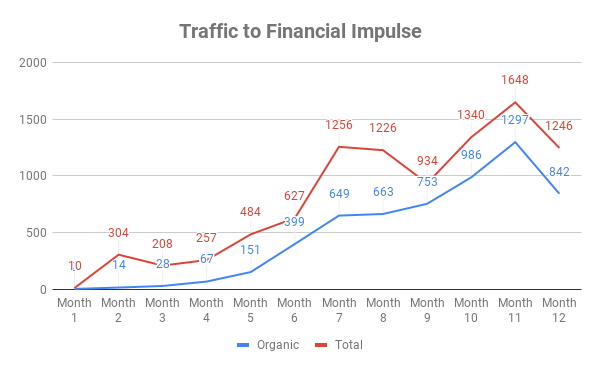After breaking away from nonprofit work a few years ago, I pivoted to an industry I knew very little about: content marketing and SEO. As someone who enjoys writing, hard data, and the social sciences, it’s been an unexpectedly satisfying career.
For those new to the concept, search engine optimization, or SEO for short, refers to the strategies and techniques used to rank a website higher in search engine results (think Google and Bing). Why is there a whole industry devoted to it?
What I appreciate most about SEO is its power to bring in traffic without constant, day-to-day maintenance. Sure, you’ll need to reoptimize and improve your content eventually, but you don’t need to spend so much on PPC or pour hours into social media. It’s a long-game strategy that tends to be more sustainable.
Of course, SEO is complicated, to say the least. To learn more about it outside of the context of my full-time job, I decided to start a website. It would be a side project to experiment with SEO techniques and to see what did and didn’t work.
Here’s how my site did in its first year.
Table of Contents
Website Background & Overview
But first, an overview of the website I started.
I launched Financial Impulse in early December 2018. As a long-time lurker of the personal finance subreddit and various personal finance blogs, I felt comfortable writing about money-related topics over the long term.
The great thing about personal finance: it encompasses so much.
For instance, on Financial Impulse, I’ve written posts about investing for beginners, cheap date ideas, and whether college is a worthwhile expense. Of course, this means my site isn’t as niche as others (e.g., blogs focused solely on investing or side hustles), but falling under this wide personal finance umbrella has given me the opportunity to test out the difficulty of ranking for different topics.
Content Strategy
On average, I estimate I spent somewhere from 2 to 8 hours a week working on Financial Impulse, though I took a brief break during the summer.
Over the course of the year, I published 44 posts. That averages out to 3.67 posts per month, or less than one post a week.
To decide what to write about, I did keyword research with SEMrush and Ahrefs, and focused mostly on long-tail keyword phrases about topics that I was interested in.
Social Media Activity
Social media doesn’t impact SEO the way many people think it does—for instance, adding social share buttons to your content doesn’t mean it’ll automatically rank higher for keywords. However, social media activity provides a way for more users to access and explore your content, which in turn, helps search engines understand user engagement on your site.
For Financial Impulse, my social media activity included the following channels:
- Twitter – I set up the @financeimpulse account to share new posts and also interact with others in the personal finance community. This was the bulk of my social media activity for Financial Impulse. Though I created the account not long after launching Financial Impulse, I didn’t start tweeting until about a month in. I gained 965 followers in 11 months.
- Pinterest – I set up an account, made pins for almost every post, joined three group boards, and pinned occasionally. Basically, I did the bare minimum.
- Facebook – I did not create a Financial Impulse page. However, using my personal account, I joined two relevant Facebook groups (FinCon Community and FinCon Weekly Content Creators), where I occasionally mentioned or linked to Financial Impulse. I joined a few other blogging/SEO Facebook groups but never shared Financial Impulse’s content in them. I also never shared Financial Impulse’s content on my personal Facebook; in fact, only 5 “IRL” people knew about the site.
Link Building, Outreach, & Content Syndication
According to Ahrefs, 60 domains actively linked to Financial Impulse in its first year. This number encompasses backlinks acquired through the following ways:
- Guest posts
- Active link building opportunities, e.g., other bloggers asking for quotes and sources
- Natural links from other sites—unlike above, this involved no outreach on my end
- Comments on other blogs
On the content syndication side, I pitched to two publications a few times. One took me up on syndication, which got two articles from Financial Impulse republished on a high-authority website.
Besides this, I republished a few posts on Medium through its Partner Program. This earned me just a little bit of money, but two Medium publications also reached out about sharing my posts with their respective audiences.
Website Analytics & Data
Search Traffic & Rankings
For transparency, here’s how Financial Impulse’s traffic (across all channels) looked over the course of its first year, with 10,083 total visitors.
However, given the site’s original purpose of learning about SEO, I’d like to focus specifically on its organic traffic. These 5,980 visitors accounted for roughly 59% of Financial Impulse’s total traffic.
On a month-by-month basis, here’s how traffic looked:
Traffic gains were pretty steady over the course of the year. Unfortunately, though, as you can see, traffic took a hit in late 2019, not long after Google’s BERT update at the end of October.
This decline is similarly reflected in SEMrush’s data on Financial Impulse. In November 2019, Financial Impulse ranked for 1,121 keywords, but this number dipped in December.
This traffic loss was a disappointing way to celebrate Financial Impulse’s one year, but of course, such is the nature of SEO.
Traffic Distribution
According to the Pareto principle, 80% of the effects generally come from 20% of the causes. I’ve wondered about this principle applied to search traffic because ideally, traffic would be distributed more evenly across a website’s posts and landing pages. (This way, a significant drop in the search performance of one page won’t severely impact the site’s overall traffic.)
For Financial Impulse, 13 posts brought in about 80% of the site’s total organic traffic. Out of 44 blog posts, that equates to roughly 30%.
While this is certainly more preferable than 20%, I’d like for more pages to bring in traffic evenly so Financial Impulse does not depend so strongly on any one page or blog post.
User Behavior
Since traffic alone does not paint a full picture of a website’s performance, here’s a look at user behavior metrics on Financial Impulse.
| Bounce Rate | Pages / Session | Average Session Duration |
| All Traffic | 32.23% | 2.09 | 00:00:53 |
| Organic | 31.14% | 1.99 | 00:00:52 |
What counts as a “good” bounce rate or session duration really depends on the industry of a given website; in other words, there is no one-size-fits-all ideal for every site on the internet. However, I’ve compared Financial Impulse’s performance to what marketing experts generally regard as the standard.
- Bounce Rate – According to the digital marketing agency RocketFuel, a bounce rate between 26% and 40% is excellent. Across all channels of traffic, the bounce rate on Financial Impulse was 32.23%, and for organic traffic only, it was slightly lower, at 31.14%. Regardless, I’m pleased with both numbers.
- Pages Per Session – With two pages per session as the “unofficial industry standard,” Financial Impulse just barely met this benchmark across all traffic.
- Average Session Duration – Unfortunately, Financial Impulse failed to meet the industry standard of 2-3 minutes with its average session duration—52 seconds for organic traffic, and 53 seconds across all visitors.
Thoughts & Observations
All things considered, I’m pleased with the results of year 1 with Financial Impulse.
Sure, it may not be the bragworthy level of traffic of Neil Patel or Brian Dean’s caliber. Nonetheless, I’m satisfied, especially considering that I didn’t share Financial Impulse with my personal network (only five friends).
With 44 blog posts published over the course of the year, I published on average less than one article per week. The fact that this relatively low number of posts still saw steady gains in search traffic reinforced three major points to me:
- Quality over quantity. It’s possible to see significant traffic gains even if you don’t post multiple times per week. Instead, the focus should be on quality. (That doesn’t always mean longer posts, by the way.)
- The importance of creating keyword-targeted content (and doing keyword research). On the whole, content created around a specific keyword phrase or cluster outperformed content that had little strategizing behind it. Sounds like a given, right? Well, I’ve wondered about this because of bloggers who kind of luck into success, writing content that that isn’t optimized the way digital marketers preach.
- It takes a village. While I kept Financial Impulse largely out of my personal network, I got involved with the online personal finance community—mostly through Twitter and Facebook. I’m certain Financial Impulse’s gains in traffic would not be possible without the help of those I interacted with online: other bloggers, content creators in general, and financial advisors and planners.
Something I had been curious about with my SEO experiment was the length of time it took for a brand new website’s content to begin ranking for various keywords. While this ultimately depends on how competitive a keyword is, I found that it was possible to begin ranking for a keyword relatively quickly.
In as early as Month 2, according to SEMrush, some of Financial Impulse’s content began ranking within Google’s top 100 search results after one month of being published. As more time passed, content began ranking faster—in as early as just a week after being published.
By Month 11 (the time of its peak organic performance), Financial Impulse ranked for 1,121 keywords. For 36 (3%) of these keywords, Financial Impulse achieved first-page rankings (positions #1 through #10). Of these 36 keywords, monthly search volume ranged from 20 to 480. However, across all keywords, the highest monthly search volume of any keyword that Financial Impulse ranked for was 27,100 (and it did so on the third page of search results).
Beyond Analytics
While I started Financial Impulse with the primary purpose of growing my SEO skills and knowledge, I got a lot more from running it.
Two major highlights from its first year:
- I won a FinCon scholarship and attended my first FinCon in Washington, D.C.
- Companies reached out to me about freelance work.
It’s been incredibly gratifying making the jump from just a lurker/reader of personal finance content to an active participant in the community. I’ve enjoyed interacting with other money enthusiasts and experts through Twitter, Facebook, email, and at FinCon—and learning about so many different perspectives along the way.
Financial Impulse has also benefited me professionally by acting as a writing portfolio. It’s helped me land new freelance clients, as well as find out about companies I’d previously never heard of.
Looking Ahead
Creating and managing Financial Impulse has been enriching on so many levels, and I’m excited to continue growing it in year 2. That said, I’m also juggling a few other projects, so I find myself vacillating on how much time I’ll be able to realistically spend on it. Admittedly, I can’t help but wonder how Financial Impulse would’ve done in its first year had I invested more time in it—for example, by publishing more posts—but I’m also fully aware of the threat of burnout.
Regardless, while content creation may slow down, I plan on continuing to monitor Financial Impulse’s analytics and search ranking performance in the next year. SEO doesn’t stand still, after all. Let’s see how it does in its second year.
If you’re a blogger and would like to get an SEO consultation, don’t hesitate to reach out. You can contact me at hello@financialimpulse.com; please include “SEO Consulting” in the subject line.




